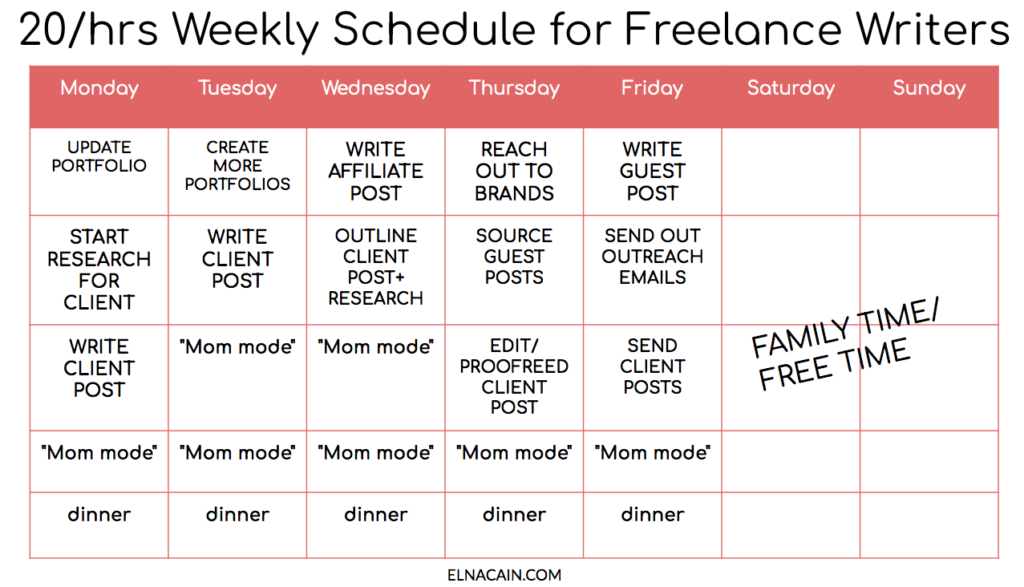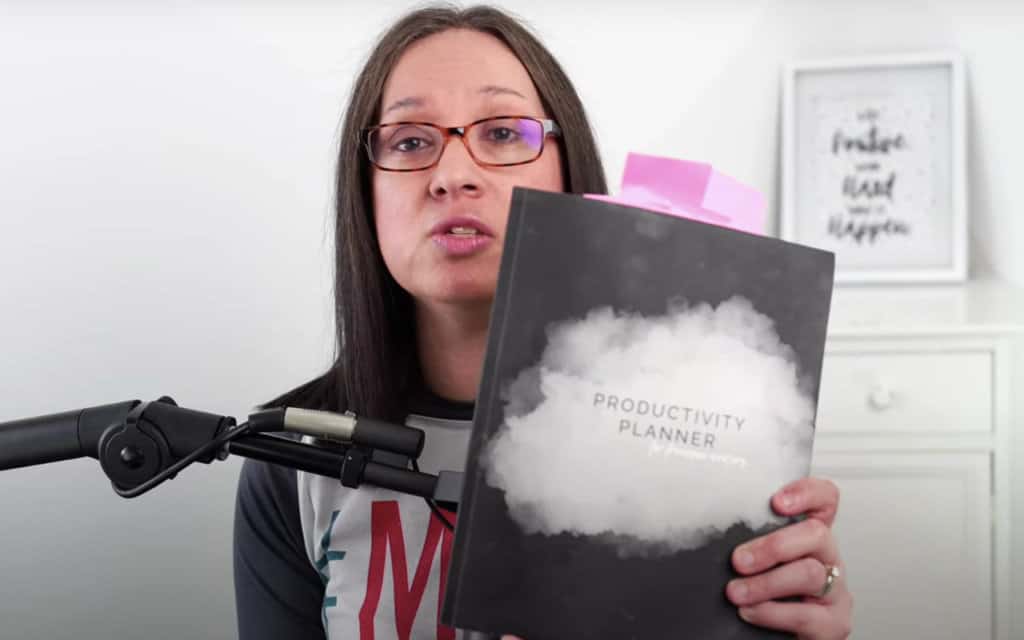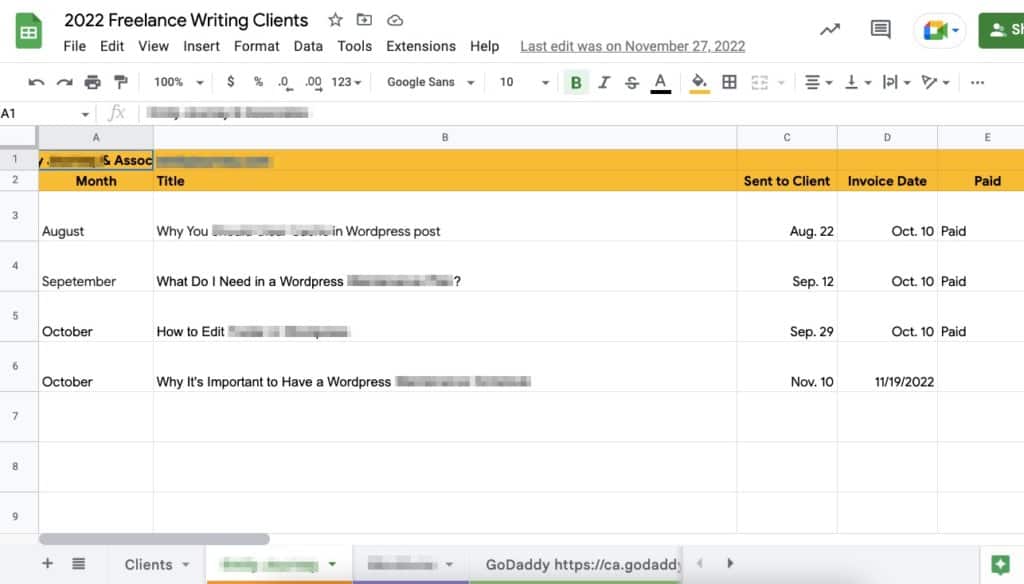Let me guess:
Every new freelance writer wants a legit writing job, right?
If that’s you, don’t count your chickens before they hatch, because what if you land three clients? Or five clients?

That would be THE DREAM, right?
Or would it? Maybe it’s A NIGHTMARE!
You finally have paid writing work, but now you have to balance multiple clients. As a new freelance writer, this is one of the skills you need to have a successful freelance writing business.
And for me…well, I struggled in the beginning. I made mistakes that cost me money and writing jobs.
It took me having to fail a bunch of times to finally find systems to help juggle multiple clients, projects, and my family.
So, if you are in the same situation as me, here are ways to manage your work as a new freelance writer.
What’s the Average Number of Clients Freelance Writers Have?
According to my report on freelance writing stats, a freelance writer’s average number of clients is 3.

With three clients, you are working with three different marketing managers, three different deadlines, three different projects, and three different terms of service.
But this is a good thing!
Having three clients is ideal as you can make a living with just three clients that pay well.
So, let’s go through how to manage it all!
Juggling Many Clients at Once

1. Figure Out How Much Time Per Day You Have for Client Work
Surveys have shown that over 40% of freelance workers are burnt out from working long days, and 65% are burnt out from a lack of work-life balance.
That’s big!
As a new freelance writer, working from morning until night can be easy, but you’ll end up exhausted and potentially hating your job.
Taking on multiple clients may seem tempting, but ensure you have enough time to get the work done without putting in too many hours.
And don’t forget to factor in other tasks like replying to emails, finding more freelance writing jobs, marketing your writing business, and taking breaks to eat and stretch.
Overall, figure out your ideal work schedule and stick to it – whether working from 9 to 5 or the afternoon into the evening.
Here’s an example schedule for a part-time freelance writer.

In my schedule, I have work time and family time. Each block can be an hour or a few hours, but the weekends are always free of work.
If you find you are burning the midnight oil to keep up with writing assignments, you have taken on too many clients!
2. Set Realistic Expectations With Your Clients
Before you manage your time and organize your projects, you must start by setting realistic expectations with your clients when submitting your work.
These include:
- Deadlines: You should always meet or EXCEED the deadlines given to you by your clients. But, the client should also give you ample time to do your work. In the next point, I’ll review how to ensure you won’t miss a deadline.
- Communication: Your client should be open to discussing the project terms with you and give you any information you need. One of my copywriting clients always provides notes on the latest project I’m working on. These notes guide me and give me the angle they want for their copy.
- Scope of work/revisions: Avoid misunderstandings by laying out the project’s terms and area of work. Does the client want it optimized for SEO? Do they want thought leadership content? Original research? How many revisions does the client need, or are you willing to give? These terms should be discussed during the negotiation phase.
- Professionalism: Both you and the client should communicate with respect and professionalism at all times. Doing this one thing can help me make more money.
Having these expectations and responsibilities as a freelance writer will help you streamline your processes and make it easier to manage clients.
But which expectation is the most important for balancing it all?
I polled my LinkedIn audience, and overwhelmingly, they chose communication as the #1 expectation to pay attention to.

And, I believe that also.
Without proper communication, you won’t be able to WOW your client and exceed their expectations.
I regularly do this with my new clients, and it’s a nice feeling when they notice this. For example, a new client said this about my content:
Amazing! simply amazing. I am speechless.
3. Mark Down Your Deadlines
To help you manage your clients when freelance writing, you NEED to know when your deadlines are. Once you are more established, you will probably be picking those deadlines.
I know for my SaaS and copywriting clients, I tell them when I can have the piece in.
But, if you just landed your first few freelance writing gigs, you can use digital or paper to mark your deadlines.
Paper Planners
I love my freelance writing planner to mark down my clients, to-do list, and deadlines.

It’s called a productivity planner for freelance writers, but I like to use it to manage my client work.
Google Sheets
In addition to my planner, I also use a digital planner – Google Sheets.
This is for my day-to-day viewing at what needs to be done and it acts as a reminder.

As you can see, most of my clients (except for Go Daddy) don’t give me a deadline, but I set my own internal deadline and make sure to give my client the posts they want for the month.
You can make your Google Sheet planner more involved if you need it.
A few years into my business, I had a more involved process for my project management system that helped me easily manage my freelance writing clients.
Trello
When I first began freelance writing, I used Trello for my blogs and clients and loved how easy it was.
I have since moved on, but it’s a great digital planner to help you mark down all your deadlines and keep you accountable.

4. Time Block Each Client
Another important aspect of balancing multiple clients is ensuring that you give each the necessary attention to complete your projects on time.
Start prioritizing client work by dividing your tasks based on deadlines and importance.
Once you have a list of what needs to be done, you can start scheduling time blocks throughout the week.
Time blocking is a time management tool that can help you stay on task and focused and is what I mostly set up during my week.

You can choose how long each block of time is but make sure they are not too long or too short – 20 to 60 minutes will work, depending on the task.
And you can adjust that time based on the nature of the task.
Easier and quick tasks can be blocked in shorter periods.
Usually, I try to front-load my week so that by Thursday, I have more free time for personal projects or to run errands.
When you start scheduling your time blocking, don’t forget the tasks I mentioned before, like marketing and job searching.
I would intersperse these tasks amongst your client work to shake things up a bit!
So for Monday, I may do the following:
Blog topics based on keyword analysis for my first block, check and write an email for my second block, conduct a Youtube video for my third block, create outlines for my client pieces for my fourth block and begin writing for one client piece for my last block.
There are also different ways that you can time block to increase your productivity:
- Time Blocking: Divide your day into different tasks, with each block of time dedicated to finishing a specific task.
- Task Batching: I’m going to talk about this in a bit, but it means that you do all of one step in a time block. For instance, you can spend all of one time block researching keywords for your client work before moving on to another task.
- Day Theming: This is a bit more difficult when you have deadlines, but you can theme your week for other non-client work tasks. For instance, Mondays for emails, Tuesdays for job searching, Wednesdays for marketing, etc.
Time blocking is extremely beneficial, especially when trying to balance multiple clients.
It helps promote deeper focus and helps you better prioritize your tasks.
5. Develop a Writing Process
Apart from organizing your time, working quickly will help you keep you sane with multiple clients and take less time to get your work.
But I’m not saying you should rush your work!
You can develop a writing process that will help keep you on track when working on client pieces.
Creating a writing routine and process ensures that you complete projects quickly and efficiently without compromising quality.
Here are steps to get you started:
- Idea Generation: If it’s on you to come up with topics for your clients, you can use Google and an AI writing tool like Jasper AI, and other blogs to generate ideas.
- Create Outlines: Creating an outline will help you structure your content in an organized and coherent way, making it easier to fill in the blanks with content.
- Research: Research your client piece to ensure the information is accurate and relevant.
- Rough Draft: Depending on the type of writer you are, you can write your content without hitting the backspace button or editing as you write.
- Editing: Even if you edit as you write, you need to let your piece breathe and look at it with fresh eyes before sending it off.
- Check for spelling and grammar errors, sentence structure, and overall flow.
Once satisfied with your piece, send it to your client!
I show your my whole process (BTS) from getting the topic to submitting my article in my Writeto1k course.

6. Batch Your Writing Process Steps
Okay, let’s talk a little more about batching your tasks.
As you can see, there are other steps involved in writing other than writing.
Between content ideas, keywords, research, and writing outlines, you can easily group these tasks across multiple clients.
For instance, you can look at your client pieces and do all your keyword research once before writing your outlines.
This is not a time management technique that works for everyone, but it can be effective in keeping your brain on task and avoiding boredom.
Even though you are doing the same task, you are moving from one topic to another instead of pushing yourself through the entire process just to start again with the next client.
You can choose to take one entire day to work on a specific task or use time blocking to keep yourself moving from task to task during the day.
7. But Finish Writing One Project Before Moving On to the Next!
While task batching is great for the work that leads up to writing an article, you must finish the actual writing part of a project before moving on to the next.
To write high-quality content quickly and efficiently, you need to get into the writing zone.
The writing zone is a place where you can write with total focus and avoid distractions.
For me, that’s in the morning when my twins are at school. For others, it can be at night, like copywriter Shawna Holmes.
I am finding out that I am becoming a night owl lol. I will get some things done while my kids are in school, but I think I’m becoming productive at night. The kicker is I avoided nightshift when I was working a regular job, now I’m over here like ‘well this isn’t bad’ lol. At home though you can write wrapped in blankets though, so it makes it better lol.
Doing this will help you balance multiple clients and complete your writing work on time!
However, that doesn’t mean you have to sit at your computer like a zombie and push yourself through a particularly cumbersome and frustrating piece of content.
If you reach this point, take a quick break to get up and stretch, use the bathroom, or have a snack.
When you sit back down, you’ll be refreshed and ready to get writing again!
The Benefits of Having Multiple Clients
There are good things about having more than one client for your freelance business. Let’s check them out.
You Can Grow Your Skills
Writing the same type of content for the same client can get boring over time. Having a wide variety of projects can help you stay interested, focused, and expand your skills.
Balancing multiple clients as a freelance writer helps diversify your day-to-day work and allows you to develop new skills and knowledge.
You Can Build a Strong Writing Portfolio
When you write for multiple clients, you can quickly build a strong and diverse portfolio showcasing your writing abilities.
I try to show my BEST clients first on my portfolio, like Smartblogger, GoDaddy, and Optinmonster.

Working for multiple clients shows you are dependable and trustworthy since more than one client can give you a testimonial.
It also shows that businesses hire you for writing, and that can vouch for your skills.
You Can Expand Your Network
Some of the best freelancing writing work comes from networking and referrals.
By working with more clients, you can build your network and increase your chances of being referred to other clients by your current clients.
Simply ask your current client if they know anyone needing writing work to expand your professional network!
You Can Earn More Money
Of course, balancing multiple freelance writing clients means that you can make more money!
Each client is an earning opportunity and having more than one client to focus on means you won’t have to rely on one client to make an income.
For my three clients, I have different rates for each of them, depending on the service and project. This helps me make more income because I can focus on only higher-paying writing jobs.
How to Reduce Your Client Load When You Have Too Many
So, after all that is said and done, you figured out you have too many clients now.
Oh no! What to do!
If you can’t handle all the work given to you, you have to reduce your client load. Here’s how.
Ask for a Raise
Go to your lowest-paying client and ask for a 20% or 30% raise.
Most likely, this client can’t afford you, and you will have to let them go. There will, however, be a rare chance they will bite and say yes.
That’s great for you since you are now making more money.
If that happens, go to your next lowest-paying client and ask for a raise.
There’s a good chance one of your clients won’t be able to accommodate you, and you have full permission to drop them.
Reduce the Amount of Work
You can also reduce the amount of work a client gives you.
I had to do this once I picked up my third client.
I already had two demanding clients and just didn’t have the bandwidth for more content.
Give yourself permission to tell your clients that you can’t do a blog post a week but you can do a blog post every other week or whatever you decide.
Take a Mental Health Break
If none of those measures work, tell your clients you need a mental health break or a break from your writing.
You can set the time frame – one month or several months.
Of course, doing this means you won’t have income coming in, so you may have to work MORE before you take a break!
Balancing Multiple Freelance Writing Clients The Right Way
I hope you found these tips helpful for managing your own freelance writing business.
For me, the most important tip is batching my work. While I do multiple tasks during the day, sometimes I do theme days.
Let me know what you do to balance multiple clients as a freelance writer! Maybe you can help other new writers out there!




2 Comments